Ten Weeks on the Camino: Nick Stark begins the most difficult section of the Camino Frances…the Meseta
Burgos to Hontanas 18.6m
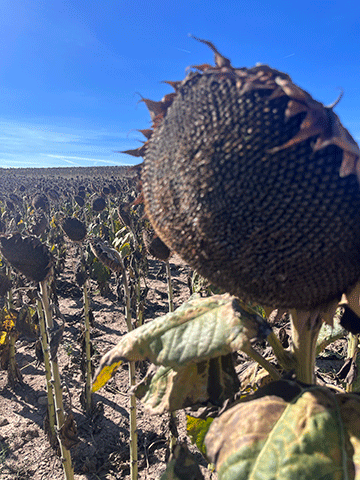
It was some relunctance that we left the wonderful town of Burgos and embarked on what many pilgrims consider the most testing section of the Camino Frances: the Meseta. This great interior plain is the tablelands, the breadbasket of Spain and stretches about 200km from Burgos to Astorga. The terrain is known for its rolling fields of wheat stretching as far as the eye can see, with wide skies and dry, relentless heat in summer and cruel, bitter cold in winter. For long stretches there are no trees, no fountains and no shade. Only the small hamlets along the route with services provide extra life to this long walk.
Those extremes cause many pilgrims to skip this section entirely, but we were walking in early October, and found it temperate but still testing, because its unrelenting nature gets under your skin, forcing you to test your mind, confront your heart, and make you wonder a little bit about your connection to this world.
Conventional pilgrim wisdom suggests it is here that you will finally start to look within and contemplate your choices in life, both those behind you and those ahead. You can block out those voice of course, by replacing them with podcasts, music or books on tape, but I was determined to resist that, and found the contemplative nature of plodding across the Meseta, one step at a time, one village at a time, one day at a time, intensely cleansing and clarifying.
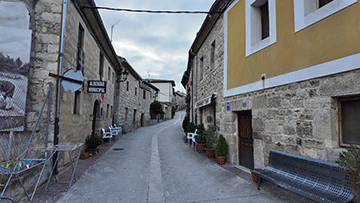
The first day’s destination was Hontanas, a charming medieval village a distant 18.6miles away. We were very footsore when we arrived at the Albergue Brigida, an airy and thoroughly modernized country farmhouse built of stone and huge local timbers. Our mood improved as we shared a Pilgrim’s Dinner with 26 others, helping ourselves from a table-sized pan of seafood paella with carafes of wine and unlimited bread and salad for 14 euros. We swapped stories with others from around the world before stumbling into bed for an early night.
Honanas to Boadilla 17.7m
From Hontanas it was only a slightly less daunting distance to Boadilla, where the modern albergue seemed to be the only real center of life in the village. For 63 euros we had a roomy, light filled room and again shared a dinner with perhaps 30 other people, one of whom was a trainee opera singer who enchanted us all with a chorus of the famed aria O Mio Babbino Caro as dinner was being served. The place seemed to be run by two staff members only, Eduardo and Sergio, who managed to serve drinks from the bar, check in the newcomers, cook, serve and clean up after both dinner and breakfast and clean the rooms during the day. They did all this with constant smiles and good humor, and their dedication to helping pilgrims was far from unique. We found, almost without exception, all the hospitaleros on our journey to be equally dedicated.
Boadilla to Carrion de los Condes 15.2m
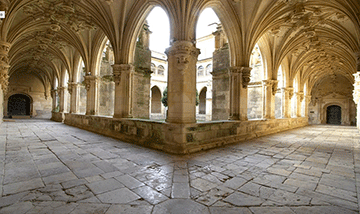
After Boadilla the rains of autumn returned, and we had a thoroughly cold and soggy all-day trudge of 15 miles to Carrion de Los Condes. The town is attractive but its charms were muted for us by the fact that we were staying at the last hotel in town, meaning we had an uphill trudge with wet feet for another 20 minutes after entering the town’s limits. But our mood was listed when we laid eyes on our destination for the night, the definitely upmarket Hotel San Zoilo, a traditional and charmingly old-fashioned hotel which is attached to the monastery of the same name and whose architecture reflected a very clerical aesthetic. We really enjoyed the hotels beautiful cloisters and Gothic arches, in addition to their hotel restaurant, where the vegetable soup, leg of lamb and a robust Rioja soon banished our grumpiness.
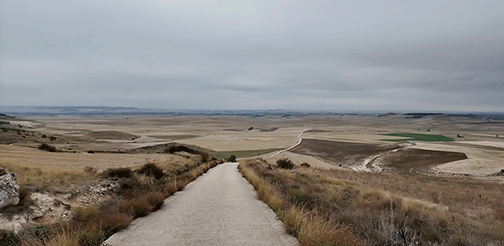
Carrion de los Condes to Ledigos 14.4m
From there it was more rain and win en route to Albergue La Morena in Ledigos. Again, this was a tiny village with obvious life to speak of outside of the Albergue, apart from one tiny bar and tienda (market) to pick up a few necessities.
By now were starting to see the same faces from our previous days: Johannes, a friendly and lanky young German with a rainbow flag attached to his backpack who looked like a young Christian Eriksen, and Jochen, a short, middle aged native of Hamburg who always sported three days stubble and had either a glass of wine or caña (draft beer in his hand). Then there was Dave and Ellie, originally from Hertfordshire but now British expats living Down Under in Sydney, and best of all, Kevin from Derbyshire, 72-year old solo traveler from who had a smile for everyone and who always would greet me with an ‘Ey up me duck’ whenever we ran across him…which was usually in a bar.
These folks became what known as our Camino family, and most of them we saw, again and again, all the way to the finish line in Santiago.
Ledigos to Sahagun 10m
More wide open skies, more rain and more wind greeted us for a completely forgettable trudge to Sahagun as the province Castille Y Leon turned into Leon proper. The only highlight would be the almost deserted village of Terradillos de los Templarios, which once housed a large detachment of Templars, one of the most famous Christian military orders. Founded in 1118, after the First Crusade, led by nine French knights, under the leadership of Hugo de Payens. Its original purpose was to protect the lives of Christians on pilgrimage to Jerusalem following its conquest. As guardians of the holy places, the Templars also extended this role to protecting the Camino de Santiago from this location in the 12th century.
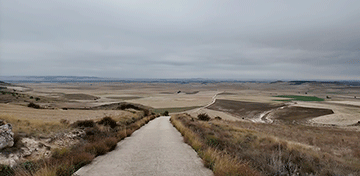
Sahagun itself is an unremarkable town, but we enjoyed one of our best meals there at the traditional Los Arcos restaurant, where their Parrilada Sampler (kind of a mixed grill) offered a groaning tray of spicy chorizo sausages, beef sirloin, tenderloin and prime rib as well as the ubiquitous loma (pork loin). The menu advertised it as serving two, but four people would have been sated too by a rather obscene amount of food.
Thanks goodness for another long walk tomorrow.
Sahagun to Leon 34miles
The long flat spaces of the Meseta continued unabated for our last two days into Leon but at least the weather cooperated. It was grey and slightly chilly, which makes for perfect hiking weather to my mind. And although the worst of this challenging stretch was over by the time the large town of Leon hove into view, we were more than happy for a rest day to enjoy what became probably our favorite spot on the Camino.
But more about that next week.
